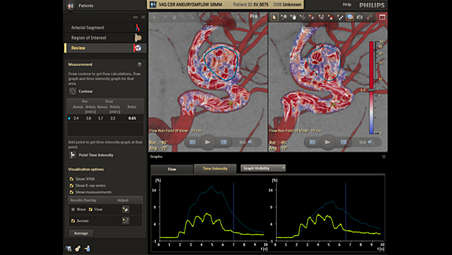- Relevant information
-
Relevant information about blood vessel flow
Flow diverters are being increasingly used to treat cerebral aneurysms, but flow diversion procedures remain challenging. Only 76% of all aneurysm flow diversion cases result in thrombosis after 6 month follow-up,¹ which poses a risk to the patient. Several authors have shown that the flow pattern inside aneurysms is considered one of the parameters that can be used to predict rupture and clotting.²,³ AneurysmFlow is the first tool that visualizes and quantifies flow changes in the parent vessel and aneurysm before and after flow diverter deployment. It also provides a unique metric – the Mean Aneurysm Flow Amplitude (MAFA) ratio. - Expanding functional understanding
-
Expanding functional understanding
Currently, a combination of digital subtraction angiography (DSA) and three-dimensional rotational angiography (3DRA) is the gold standard for imaging vascular lesions, but it provides limited functional information about flow. AneurysmFlow uses novel algorithms based on the optical flow principle to convert information from a 3DRA acquisition and 2D DSA flow sequences into quantitative flow values. These values are used to visualize and quantify flow dynamics before and after flow diverter deployment in cerebral aneurysms. - Enhances decision making
-
Enhances decision making
AneurysmFlow automatically measures the following parameters within the region of interest defined: time averaged arterial flow, time and spatially averaged projected aneurysm flow, and Mean Aneurysm Flow Amplitude (MAFA) ratio. Users can also view the following information as graphs: time dependent arterial flow and time dependent, spatially averaged projected aneurysm flow. - New information
-
New information with Mean Aneurysm Flow Amplitude ratio
The Mean Aneurysm Flow Amplitude (MAFA) ratio represents the change in blood flow in the aneurysm after flow diverter deployment. The MAFA ratio is derived by comparing the average projected velocity of the blood flow in the aneurysm before and after flow diverter deployment. This ratio is corrected for average velocity change of the blood flow in the primary feeding vessel to the aneurysm. - Step-by-step workflow
-
Step-by-step workflow
AneurysmFlow supports endovascular treatment of saccular cerebral aneurysms with embolization devices, such as flow diverters. Data acquisition can be controlled at the tableside during the normal workflow, while analysis is performed in the control room.
Relevant information about blood vessel flow

Relevant information about blood vessel flow

Relevant information about blood vessel flow
Expanding functional understanding

Expanding functional understanding

Expanding functional understanding
Enhances decision making

Enhances decision making

Enhances decision making
New information with Mean Aneurysm Flow Amplitude ratio

New information with Mean Aneurysm Flow Amplitude ratio

New information with Mean Aneurysm Flow Amplitude ratio
Step-by-step workflow

Step-by-step workflow

Step-by-step workflow
- Relevant information
- Expanding functional understanding
- Enhances decision making
- New information
- Relevant information
-
Relevant information about blood vessel flow
Flow diverters are being increasingly used to treat cerebral aneurysms, but flow diversion procedures remain challenging. Only 76% of all aneurysm flow diversion cases result in thrombosis after 6 month follow-up,¹ which poses a risk to the patient. Several authors have shown that the flow pattern inside aneurysms is considered one of the parameters that can be used to predict rupture and clotting.²,³ AneurysmFlow is the first tool that visualizes and quantifies flow changes in the parent vessel and aneurysm before and after flow diverter deployment. It also provides a unique metric – the Mean Aneurysm Flow Amplitude (MAFA) ratio. - Expanding functional understanding
-
Expanding functional understanding
Currently, a combination of digital subtraction angiography (DSA) and three-dimensional rotational angiography (3DRA) is the gold standard for imaging vascular lesions, but it provides limited functional information about flow. AneurysmFlow uses novel algorithms based on the optical flow principle to convert information from a 3DRA acquisition and 2D DSA flow sequences into quantitative flow values. These values are used to visualize and quantify flow dynamics before and after flow diverter deployment in cerebral aneurysms. - Enhances decision making
-
Enhances decision making
AneurysmFlow automatically measures the following parameters within the region of interest defined: time averaged arterial flow, time and spatially averaged projected aneurysm flow, and Mean Aneurysm Flow Amplitude (MAFA) ratio. Users can also view the following information as graphs: time dependent arterial flow and time dependent, spatially averaged projected aneurysm flow. - New information
-
New information with Mean Aneurysm Flow Amplitude ratio
The Mean Aneurysm Flow Amplitude (MAFA) ratio represents the change in blood flow in the aneurysm after flow diverter deployment. The MAFA ratio is derived by comparing the average projected velocity of the blood flow in the aneurysm before and after flow diverter deployment. This ratio is corrected for average velocity change of the blood flow in the primary feeding vessel to the aneurysm. - Step-by-step workflow
-
Step-by-step workflow
AneurysmFlow supports endovascular treatment of saccular cerebral aneurysms with embolization devices, such as flow diverters. Data acquisition can be controlled at the tableside during the normal workflow, while analysis is performed in the control room.
Relevant information about blood vessel flow

Relevant information about blood vessel flow

Relevant information about blood vessel flow
Expanding functional understanding

Expanding functional understanding

Expanding functional understanding
Enhances decision making

Enhances decision making

Enhances decision making
New information with Mean Aneurysm Flow Amplitude ratio

New information with Mean Aneurysm Flow Amplitude ratio

New information with Mean Aneurysm Flow Amplitude ratio
Step-by-step workflow

Step-by-step workflow

Step-by-step workflow
- 1. Brinjikji W, Murad MH, Lanzino G. et al. Endovascular treatment of intracranial aneurysms with flow diverters: a meta-analysis. Stroke. 2013;44:442–447.
- 2. Augsburger L, et al. Methodologies to assess blood flow in cerebral aneurysms: Current state of research and perspectives. J Neurorad. 2009;36:270–277.
- 3. Sforza DM, Putman CM, Cebral JR. Hemodynamics of Cerebral Aneurysms. Annu Rev Fluid Mech. 2009; 41:91–107.
- This product is based on open source software.
